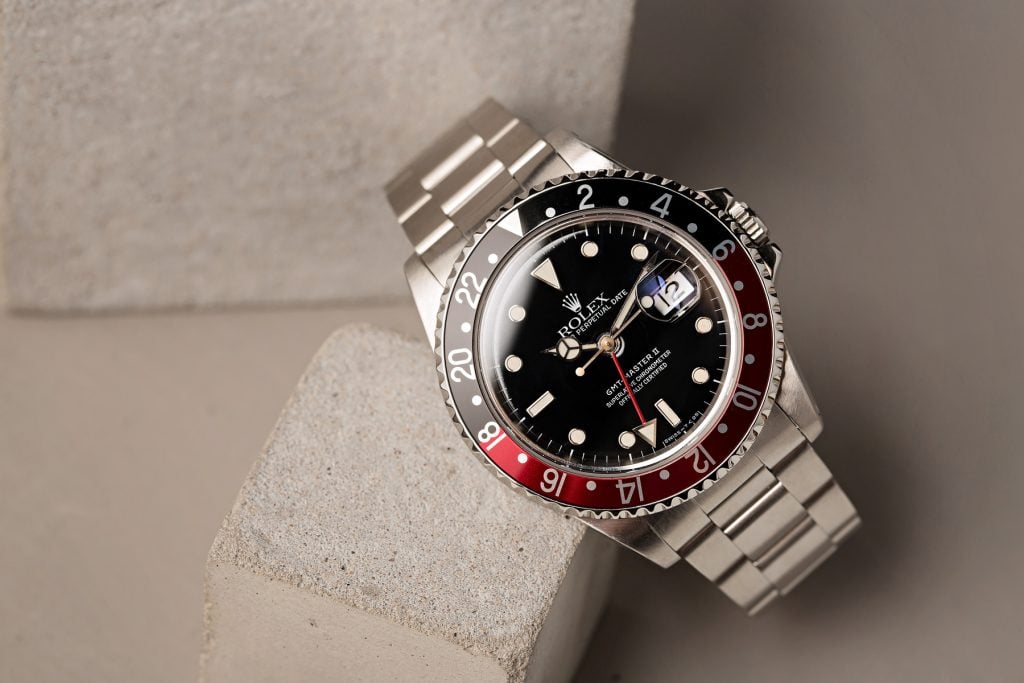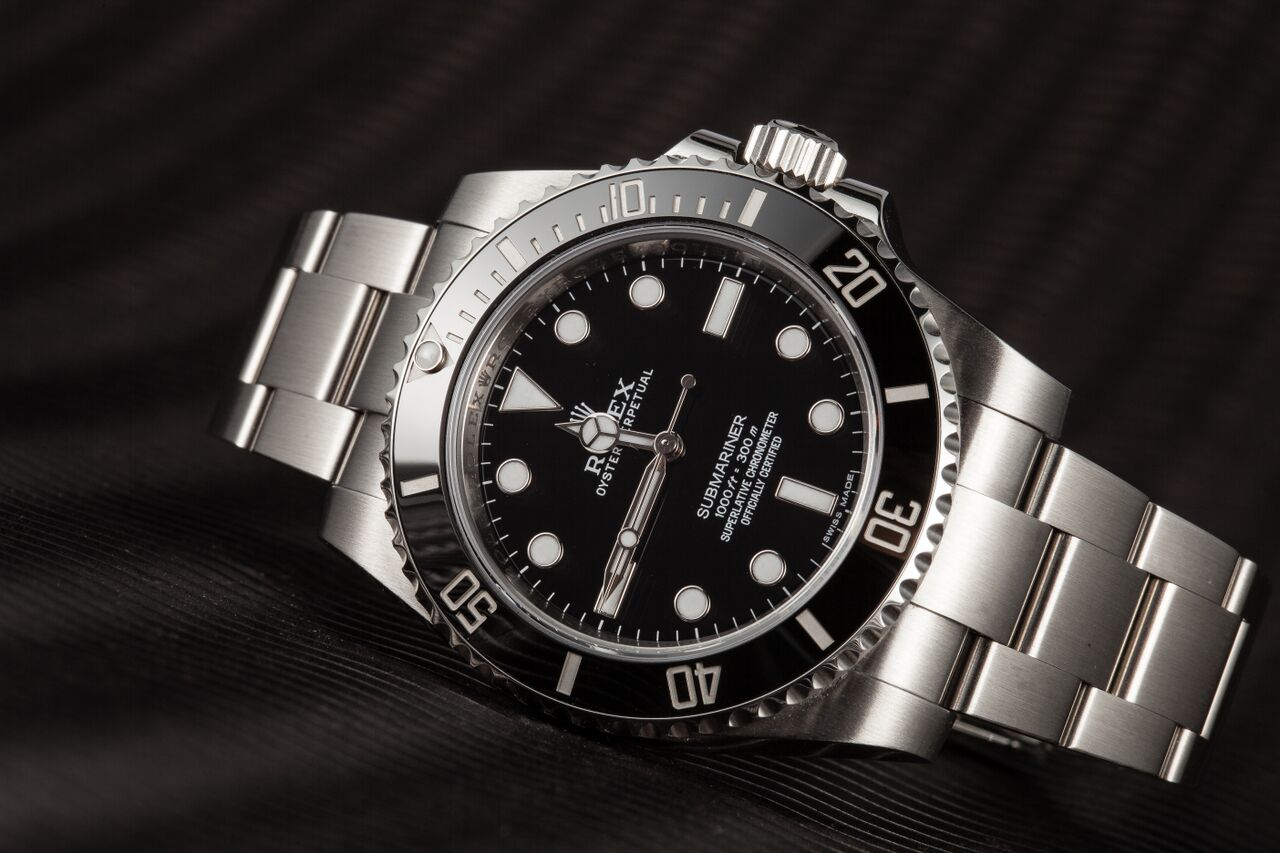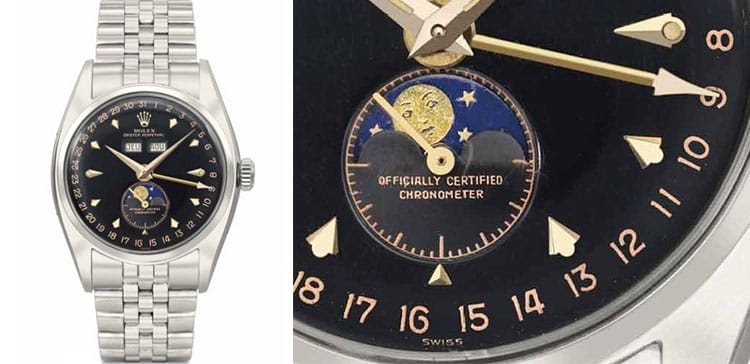As any collector knows, when Rolex rolls out a new version of one of its most iconic designs, modernizes it with a host of never-before-seen features and then keeps the production run relatively short, that watch is going to become a hot ticket on the pre-owned market. There are a number of such models in the Rolex stable, but the Rolex Fat Lady watch, the original Rolex GMT-Master II ref. 16760, remains one of the more enduring must-haves.
Perhaps the most corner-of-the-eye recognizable watch in the whole catalog, the bi-color bezel of the various Rolex GMT Master models has ensured they’ve never been mistaken for the Submariner, although the two series have always been stylistically similar and were released around the same time in the mid-fifties.
Aside from being the first Rolex GMT Master II, the reference 16760 boasts numerous innovations and is an absolute icon. Let’s take an in-depth look at the beloved ‘Fat Lady’ and find out what makes this inaugural GMT-Master II reference special.
Click here for our Ultimate Buying Guide on the Rolex GMT-Master II.
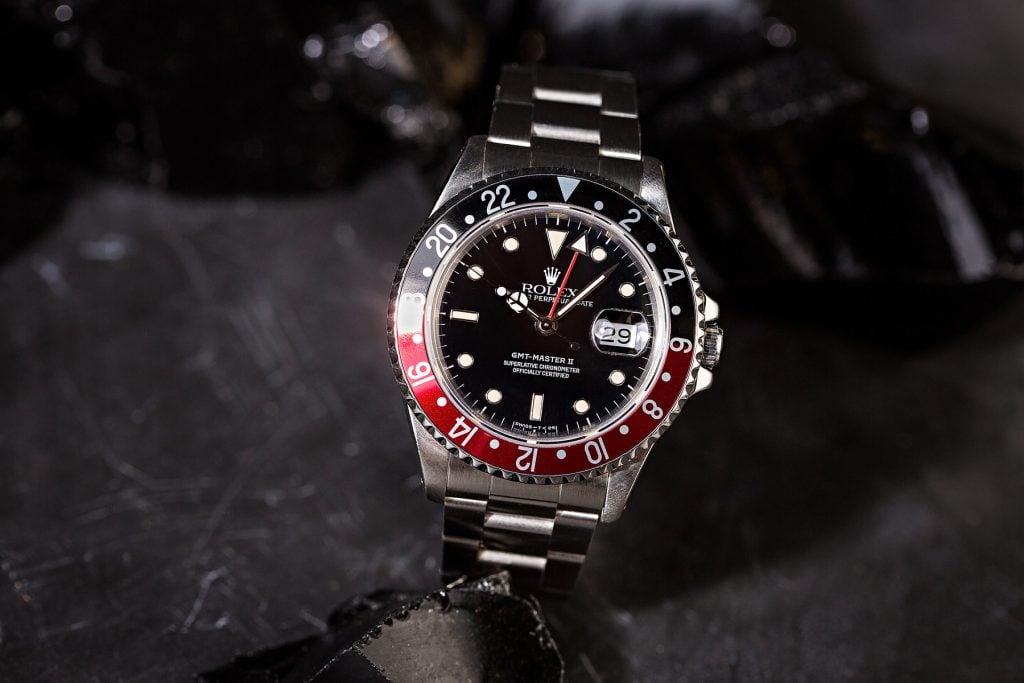
Rolex GMT-Master 16760 History
Developed in conjunction with Pan Am as a way for their pilots to keep track of different time zones during transatlantic flights, the GMT Master quickly became a favorite among military pilots too and even found their way onto the wrists of NASA’s astronauts — Jack “Houston, we have a problem” Swigert wore one on the ill-fated Apollo 13 mission. More recently, fellow watch collector John Mayer has been spotted with a Pepsi bezel GMT on his wrist, as has 007 actor Daniel Craig. The Rolex GMT Master also won an enthusiastic fan base among high-mileage business travelers, who found having both the local and home time zones set on their watch offset some of the mental strains of jet-lag.
Rolex introduced the GMT-Master in the 1950s with ref. 6542. Early editions featured the ill-fated Bakelite bezel, which was quickly replaced by aluminum because of its tendency to crack. Aluminum remained the go-to bezel material until the 2000s when Rolex’s patented “Cerachrom” ceramic material replaced it.
References 1675, 16750, and 16700 followed. However, there was some overlap between the original GMT-Master and the GMT-Master II with the ref. 16750 (1981 – 1988) remaining in production alongside the GMT-Master II ‘Fat Lady’ ref. 16760 (1982 – 1988). Also, the ref. 16700 GMT-Master introduced after the Fat Lady ceased production remained a fixture of the Rolex catalog until 1999, overlapping with the GMT-Master II considerably. As a result, the ref. 16700 received many upgrades not afforded to its predecessors, such as sapphire crystal and improved luminescent material. The reference 16700 was the very last of the GMT-Master references.
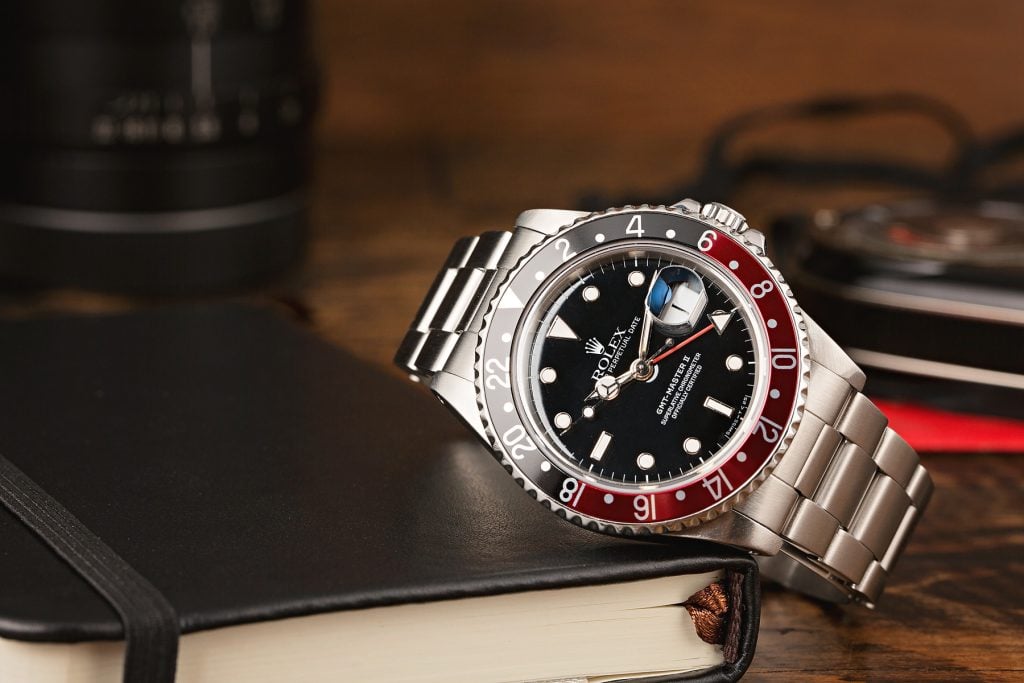
The Rolex GMT-Master II 16760 ‘Fat Lady’
Such was the watch’s popularity, the original GMT-Master stayed in production right up until 1999. It had, of course, gone through a host of major updates in its nearly 45-year lifespan, but even the introduction of its supposed replacement, the first of the GMT-Master II range in 1982, couldn’t clip its wings.
The body-shaming nickname for that initial reference, the 16760, alternatively known by the more complimentary moniker “Sophia Loren,” came from the elegant curves of its generously enhanced proportions, a necessary design feature in order to house the all-new movement inside, the cal. 3085.
The case is thicker, yet it keeps the standard 40mm measurement and 100-meter depth rating. It was also produced on the three-link Oyster or five-link Jubilee bracelets and featured Tritium luminescent material on the dial – the standard for Rolex watches made during the 1980s.
Although the quickset date function had to be sacrificed, the new movement was a logical addition to the ultimate travelers watch, as it finally allowed for the uncoupling of the hour hand from the GMT hand. This meant that setting the second time zone at your destination was now instantaneous, with the local 12-hour hand able to jump backwards or forwards independently from the arrow tipped 24-hour hand. As a result, it was even possible to keep track of a third timezone by reading the 24-hour hand’s position against the eye-catching rotating bezel.
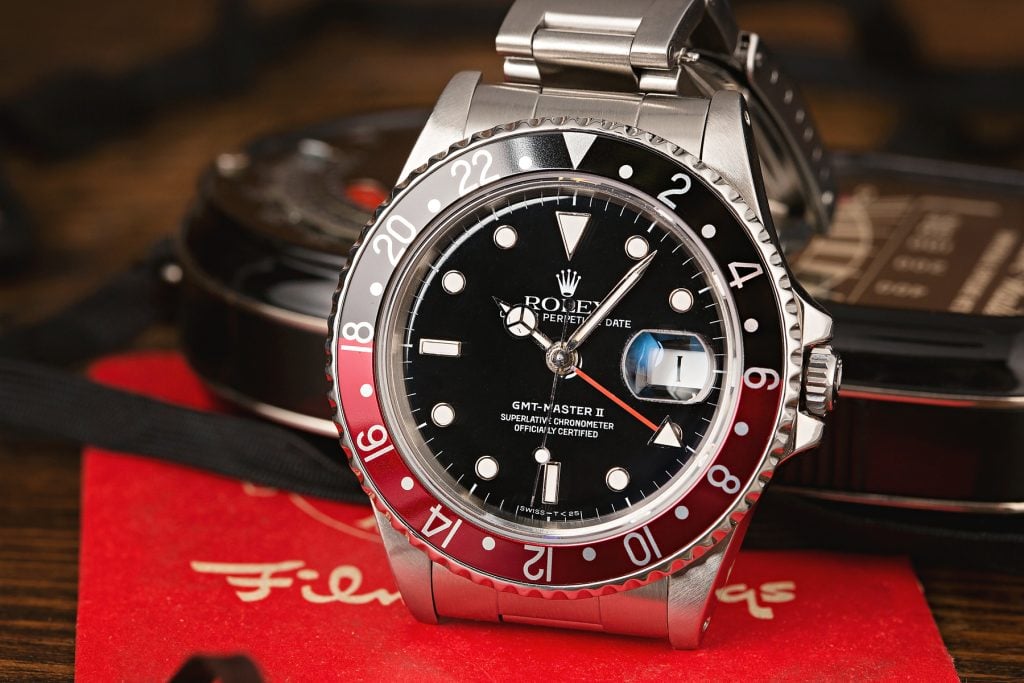
The “Coke” GMT-Master II 16760
The various two-tone color schemes have always been one of the major selling points for the GMT. When the first of the Cerachrom versions was released in 2005 with an all black bezel, Rolex insisted it was impossible to add a second color to their new proprietary ceramic, the GMT faithful were decidedly unimpressed. (The ‘impossible’ blue and black Cerachrom Batman version was released soon after.)
Along with being aesthetically attractive and working to set the watch apart from other sports models in the range, the contrasting colors on the bezel played an important role in helping jet-lagged wearers distinguish between night and day as they traveled between time zones. The original watch from the 1950s had quickly picked up the label ‘Pepsi’ for its blue and red bezel, with the blue representing the daytime and red the night. It was later joined by the brown and gold ‘Root Beer’ (otherwise known in some circles as the Clint Eastwood).
The Fat Lady was the first in the range to sport a black and red surround, instantly dubbed the Rolex Coke bezel by watch collectors and ensuring the 16760 became the watch with one of the highest numbers of unofficial nicknames attached to it in Rolex’s long history. It was the only color scheme available during its relatively short run, and it never appeared in a precious metal variant, unlike the GMT-Master, which had introduced steel/gold and full 18k gold luxury versions. The Fat Lady with its red and black “Coke” bezel was always stainless steel.
A number of other firsts also found their way on to the original GMT-Master II. The acrylic crystal was replaced with the more scratch resistant sapphire and it became the first in the series to use white gold to surround the indexes. Both features are now standard issue on all Rolex watches.
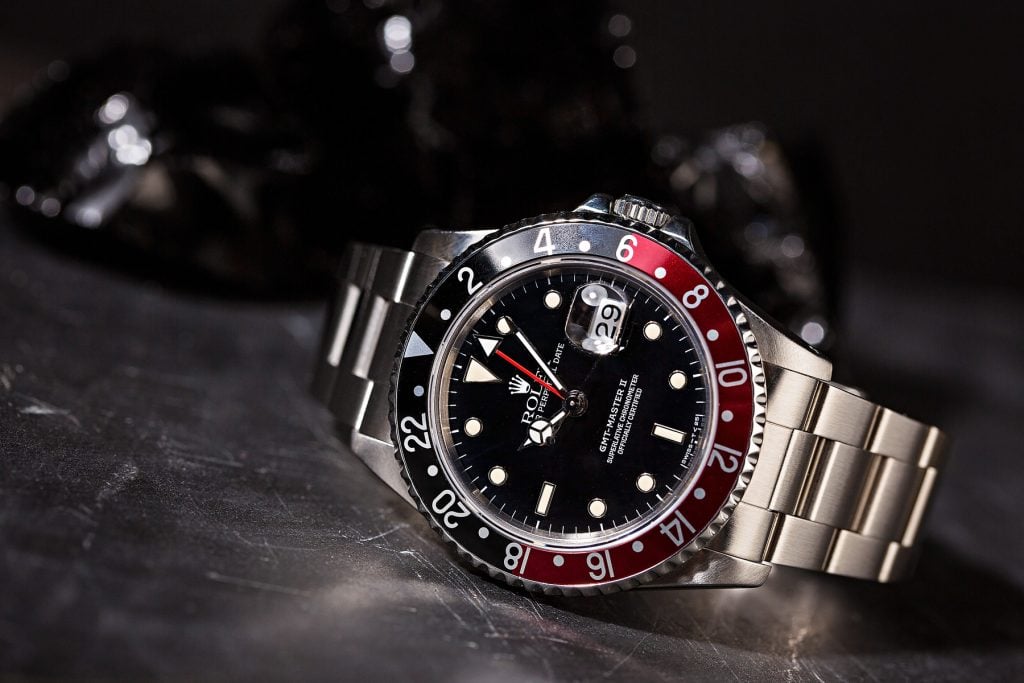
A New Generation of Rolex GMT Watches
The 16760, while not quite ‘blink and you’ll miss it’, was only in production from 1982 to 1988. Its replacement, the 16710, was powered by a newer, slimmer caliber (the 3185) that, while identical in functions, allowed for a return to more slender, graceful bodywork.
The reference 16710 carried on the Coke bezel legacy, although it also sported the red and blue Pepsi bezel and an all-black bezel. Interestingly, the ref. 16710 would be the last sighting of the Coke bezel within the GMT series, as we have yet to see the red and black colorway produced in ceramic. Of course, this fact only adds to the 16760 and 16710’s collectability.
The GMT series has enjoyed a strong following among Rolex devotees ever since its introduction. Seen as the archetypal aviator’s watch in the same way that the Submariner has always been the go-to for professional divers, the first of the GMT-Master II offerings has garnered a warmly affectionate fan base among collectors. Its never-before-seen coloration and host of innovative qualities make it an important milestone in the history of the brand, and its short five-year run lend it that indispensable air of exclusivity.
As of the writing of this article, the Rolex 16760 trades hands for around $14k on the pre-owned market. Not a bad entry-level price for a vintage GMT-Master II with so much historical significance. For comparison, the ceramic bezel GMT-Master II ref. 116710 also resells for around $14k, and its predecessor, ref. 16710 will set you back anywhere between $12k and $15k, depending on the condition of the watch and its specific set of feature.
Even so, the Rolex GMT-Master II reference 16760 represents something of a bargain on the pre-owned market for a model with so much pedigree. While finding an example in good condition can take some searching, those new to the world of vintage watches are often pleasantly surprised by just how attainable they can be and, for many a fan, it marks the start of their journey into Rolex collecting.
